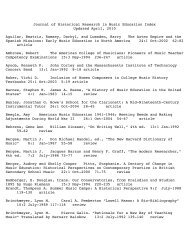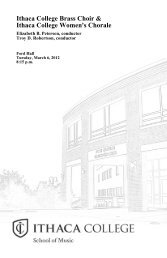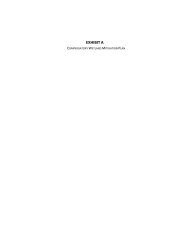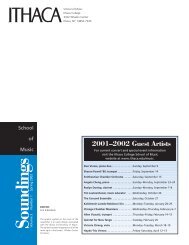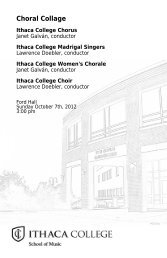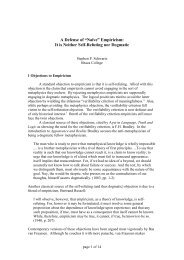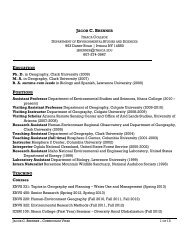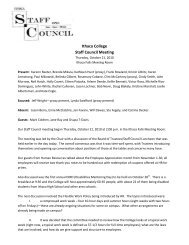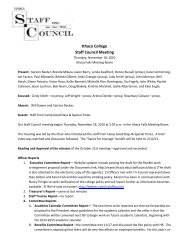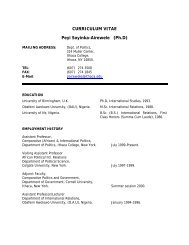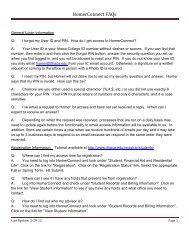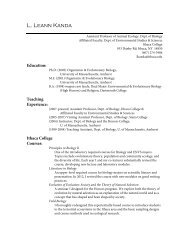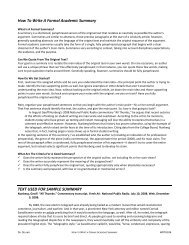Environmental Science Book List Abbey, E. The monkey wrench ...
Environmental Science Book List Abbey, E. The monkey wrench ...
Environmental Science Book List Abbey, E. The monkey wrench ...
You also want an ePaper? Increase the reach of your titles
YUMPU automatically turns print PDFs into web optimized ePapers that Google loves.
303-15200: <strong>Environmental</strong> <strong>Science</strong> II Spring 2003<br />
<strong>Environmental</strong> <strong>Science</strong> <strong>Book</strong> <strong>List</strong><br />
<strong>Abbey</strong>, E. <strong>The</strong> <strong>monkey</strong> <strong>wrench</strong> gang. <strong>The</strong> backlist bestselling underground cult classic that<br />
raised American consciousness of environmentalism, reissued in a trade paperback edition. When<br />
a gang of renegades sets forth on their mission to destroy the power lines, new road and bridges<br />
springing up across their cherished desert, all hell breaks loose.<br />
<strong>Abbey</strong>, E. Desert solitaire. 337 pages Ballantine <strong>Book</strong>s (Mm). Reissue edition (April 1991). With<br />
language as colorful as a Canyonlands sunset and a perspective as pointed as a prickly pear,<br />
Cactus Ed captures the heat, mystery, and surprising bounty of desert life. Desert Solitaire is a<br />
meditation on the stark landscapes of the red-rock West, a passionate vote for wilderness, and a<br />
howling lament for the commercialization of the American outback.<br />
Antonetta, S. Body Toxic: An <strong>Environmental</strong> Memoir<br />
In this harrowing yet lovely memoir, poet Antonetta (Bardo) describes her childhood vacations in<br />
New Jersey's Pine Barrens, a holiday spot replete with crabbing, fishing and sunbathing and a local<br />
water system tainted by nuclear waste, pesticides, cyanide, lead, mercury and other poisons. Some<br />
30 years later, she relates, that region "is the center of a cluster of childhood cancers of the brain<br />
and nervous system.”<br />
Baskin, Y., A. Rorer and P.Ehrlich. 1997. <strong>The</strong> Work of Nature : How the Diversity of Life<br />
Sustains Us. 288 pages. Island Press. Baskin, a science journalist with a pleasingly lucid style,<br />
reports on the findings of an innovative ecological survey conducted in the hopes of answering the<br />
question, "What are the possible consequences of the accelerating losses in biodiversity?"<br />
Berry, W. 1996. <strong>The</strong> Unsettling of America.. Sierra Club <strong>Book</strong>s, San Francisco, CA. A<br />
Kentucky farmer writes about the consequences of Americans losing respect for land and each<br />
other, primarily from an agricultural perspective.<br />
Bullard, R.D. 1994. Unequal protection. Sierra Club <strong>Book</strong>s, San Francisco, CA. 392 pages. A<br />
compendium of case studies of environmental problems facing communities of color and the need<br />
for better environmental justice.<br />
Callenbach, E. 1975 (reissued in 1990). Ecotopia. Bantam <strong>Book</strong>s. 181 pages. Ecotopia was<br />
founded when northern California, Oregon, and Washington seceded from the Union to create a<br />
"stable-state" ecosystem: the perfect balance between human beings and the environment. Now,<br />
twenty years later, the isolated, mysterious Ecotopia welcomes its first officially sanctioned<br />
American visitor: New York Times-Post reporter Will Weston. Like a modern Gulliver, the<br />
skeptical Weston is by turns impressed, horrified, and overwhelmed by Ecotopia's strange<br />
practices: employee ownership of farms and businesses, the twenty-hour work week, the fanatical<br />
elimination of pollution, "mini-cities" that defeat overcrowding, devotion to trees bordering on<br />
worship, a woman-dominated government, and bloody, ritual war games. Bombarded by<br />
innovative, unsettling ideas, set afire by a relationship with a sexually forthright Ecotopian<br />
woman, Weston's conflict of values intensifies-and leads to a startling climax.<br />
Callenbach, E. 1981. Ecotopia Emerging. Banyan Tree <strong>Book</strong>s. A multistranded novel<br />
dramatizing the rise and triumph of a powerful American movement to preserve the earth as a<br />
safe, habitable environment. Its heroine is a brash and brilliant highschool student who invents a
303-15200: <strong>Environmental</strong> <strong>Science</strong> II Spring 2003<br />
better photovoltaic cell. Her mother organizes "cancer commandos." Figures who also appear in<br />
ECOTOPIA, to which this is a "prequel," first join the story here. An epic: the birth of a new<br />
nation.<br />
Carson, R. 1962. Silent Spring. Houghton Mifflin Co., Boston, MA. 368 pages. A landmark<br />
book on the environmental consequences of pesticide use.<br />
Colborn, T., Dumanoski, D., and J. P. Myers. 1996. Our Stolen Future, Dutton Publ. (Penguin<br />
<strong>Book</strong>s), NY. 305 pages. Following in the tradition of Silent Spring, this book investigates<br />
whether chemicals in the environment are disrupting the reproductive function of animals and<br />
humans.<br />
Daily, G.C. (Ed.) and J. Reichert. 1997. Nature's Services: Societal Dependence on Natural<br />
Ecosystems. Island Press. 416 pages. Nature's Services brings together world-renowned scientists<br />
from a variety of disciplines to examine the character and value of ecosystem services, the<br />
damage that has been done to them, and the consequent implications for human society.<br />
Contributors present a detailed synthesis of our current understanding of a suite of ecosystem<br />
services and a preliminary assessment of their economic value.<br />
Ehrlich, P.R., Ehrlrich, A.H. and G.C. Daily. 1995. <strong>The</strong> Stork and the Plow : <strong>The</strong> Equity<br />
Answer to the Human Dilemma. Putnam’s. 384 pages.<br />
Gore, A. 1992. Earth in the Balance: ecology and the human spirit. 432 pages. Houghton<br />
Mifflin, NY. Global warming. <strong>The</strong> deteriorating ozone layer. <strong>The</strong> rapid destruction of the world's<br />
rain forests. Rising carbon dioxide levels. This bestselling work on our planet's environmental<br />
crisis gives a shocking account of just how serious all of these problems have become. <strong>The</strong><br />
vice-presidential candidate describes how far-reaching the environmental crisis is and calls for a<br />
radical change in human civilization's relationship with the planet.<br />
Grant, L. 1996. Juggernaut: growth on a finite planet. Seven Locks Press, Washington, DC.<br />
310 pages. An interdisciplinary perspective on the causes and consequences of global population<br />
growth. Fairly technical.<br />
Harden, B. 1996. A River Lost. This book is a historical review of the management of the<br />
Columbia River. It integrates information of water management, agricultural practices, nuclear<br />
energy production, and preserving runs of anadromous salmon.<br />
Harr, J. 1996. A Civil Action, Vintage <strong>Book</strong>s (Random House), NY, 502 pages. This is a nonfictional<br />
account of a legal battle between a small community and corporate America over<br />
chemical contamination of well water.<br />
Leopold, A.C. 1946. A sand county almanac. Ballantine <strong>Book</strong>s. A classic in environmental<br />
science. <strong>The</strong>se astonishing portraits of the natural world explore the breathtaking diversity of the<br />
unspoiled American landscape -- the mountains and the prairies, the deserts and the coastlines. A<br />
stunning tribute to our land and a bold challenge to protect the world we love.<br />
Jensen, D. A Language Older Than Words
303-15200: <strong>Environmental</strong> <strong>Science</strong> II Spring 2003<br />
“Every morning I wake up and ask myself whether I should write a book or blow up a dam,"<br />
writes Jensen in his opening pages. "Every day I tell myself I should continue to write. Yet I'm not<br />
always convinced I'm making the right decision." This is the agony of an environmentalist and a<br />
pacifist who has come to realize that he's been throwing snowballs at army tanks. While he<br />
debates and negotiates with the polluters, the developers and the industrialists, they continue their<br />
destructive activities virtually unimpeded. How long, wonders Jensen, can we afford to go on<br />
being pacifists?<br />
Quinn, Daniel. Ishmael, Bantam <strong>Book</strong>s 263 pages. Reissue edition (June 1995). <strong>The</strong> narrator of<br />
this extraordinary tale is a man in search for truth. He answers an ad in a local newspaper from a<br />
teacher looking for serious pupils, only to find himself alone in an abandoned office with a<br />
full-grown gorilla who is nibbling delicately on a slender branch. "You are the teacher?" he asks<br />
incredulously. "I am the teacher," the gorilla replies. Ishmael is a creature of immense wisdom and<br />
he has a story to tell, one that no other human being has ever heard. It is a story that extends<br />
backward and forward over the lifespan of the earth from the birth of time to a future there is still<br />
time save. Like all great teachers, Ishmael refuses to make the lesson easy; he demands the final<br />
illumination to come from within ourselves. Is it man's destiny to rule the world? Or is it a higher<br />
destiny possible for him-- one more wonderful than he has ever imagined?<br />
Revkin, A. <strong>The</strong> Burning Season : <strong>The</strong> Murder of Chico Mendes and the Fight for the Amazon<br />
Rain Forest. 1994. Plume Publ. A well-researched and deftly written account of the life and times<br />
of Mendes, the Brazilian rubber tapper and grass-roots environmentalist who was murdered in<br />
1988 by ranchers intent on their short term gain.<br />
Steingraber, S. Having Faith: An Ecologist's Journey to Motherhood<br />
Steingraber (Living Downstream) offers the commonest of stories how she got pregnant, gave<br />
birth and fed her baby in a most uncommon way. A cross between the quirkily thorough detail of<br />
Natalie Angier's science-writing and the passionate environmental advocacy of Rachel Carson,<br />
Steingraber's style would have been insufferably heroic if the pregnancy had been smooth,<br />
mind-over-matter. <strong>The</strong> climax, however, is not her daughter Faith's birth, but the dilemma over<br />
the safety of breastfeeding. <strong>The</strong> medical benefits of breast milk are compelling: it provides<br />
excellent nutrition and important immunities. But with rising environmental pollution,<br />
biomagnification implies that deadly toxins like DDT and dioxin will concentrate in human milk,<br />
the top of the food chain. <strong>The</strong> only answer: fight this pollution and make the world safer for<br />
nursing babies. With humor Steingraber compares childbirth to rocking a car out of a snowdrift or<br />
angling big furniture through a small doorway to leaven the scientific forays, this is a positively<br />
riveting narrative.<br />
Steingraber, S. Living Downstream: A Scientist's Personal Investigation of Cancer and the<br />
Environment<br />
With this eloquent and impassioned book, biologist and poet Sandra Steingraber shoulders the<br />
legacy of Rachel Carson, producing a work about people and land, cancer and the environment,<br />
that is as accessible and invaluable as Silent Spring--and potentially as historic.<br />
In her early twenties, Steingraber was afflicted with cancer, a disease that has afflicted other<br />
members of her adoptive family. Writing from the twin perspectives of a survivor and a<br />
concerned scientist, she traces the high incidence of cancer and the terrifying concentrations of<br />
environmental toxins in her native rural Illinois. She goes on to show similar correlation in other<br />
communities, such as Boston and Long Island, and throughout the United States, where cancer
303-15200: <strong>Environmental</strong> <strong>Science</strong> II Spring 2003<br />
rates have risen alarmingly since mid-century. At once a deeply moving personal document and<br />
a groundbreaking work of scientific detection, Living Downstream will be a touchstone for<br />
generations, reminding us of the intimate connection between the health of our bodies and the<br />
integrity of our air, land, and water.<br />
Williams, T T. 1992. Refuge. Vintage <strong>Book</strong>s, 304 pages. A woman’s perspective on the effects<br />
of development and nuclear weapon testing on the wilderness and people living in the American<br />
West.




